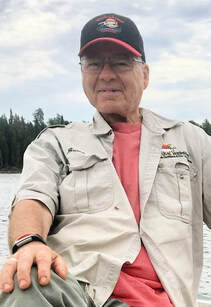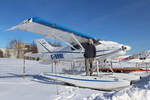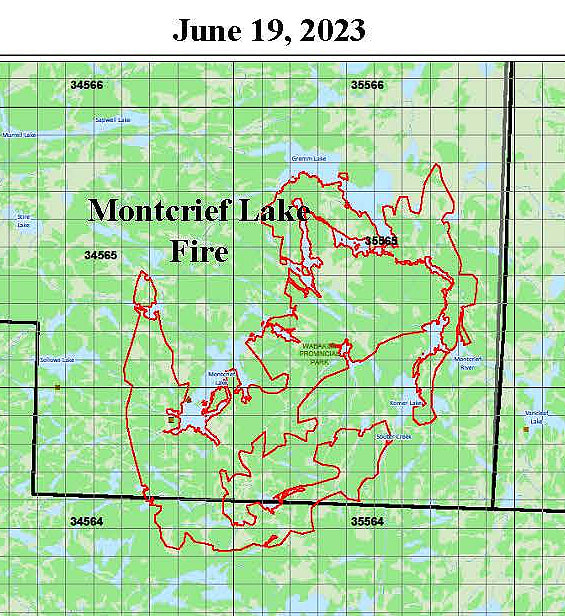|
Wabakimi Voices
(Bruce Hyer is the longtime proprietor of the Wabakimi Canoe Outfitters and Ecolodge. His early efforts for creation of Wabakimi Provincial Park are chronicled in this chapter in “Islands of Hope” 1992. He previously served two terms as Member of Parliament and has been the Green Party candidate in the last two elections. Enjoy his recent slideshow. This interview was conducted by FOW Board Chair Dave McTeague.) First, this has been a tough year or more with the pandemic and border closures. How are you doing? Doing fine. I’ll be 75 in August, but I’m still clearing portage trails, guiding the odd trip, teaching whitewater, flying my float plane and building docks. I have three predictions, the Wabakimi ice will go out on May 10th, I’ll be paddling and clearing trails on May 11th, and the border will open with some conditions (vaccination/testing) no later than July 1. What were the dynamics that helped create Wabakimi Provincial Park in the first place? When I was living at Shawanabis Lake, I worked on this along with Don Plumridge, a fly-in operator, and the late Bruce Peterson who represented the World Wildlife Fund and Environment North. It was a hard sell. I thought it would take five years; it took twenty-five years. Nobody up here wanted it. Armstrong didn’t want it, the loggers and miners, the government, the Ministry of Natural Resources, and most of the First Nations didn’t want it. We made many trips to Ottawa and Toronto. You have to be persistent and play both softball and hardball. Since then most people locally and regionally have come to appreciate it. What dynamics drove the expansion of the park in 1995? I wrote a letter to the Natural Resources Minister Chris Hodgson about “postage stamp” Wabakimi Provincial Park, asking him to consider small expansions. All the values, biological and geophysical for which the park was originally created were left out. This led to the Wabakimi Park Boundary Committee. Dr. Peter Duinker (forestry professor) chaired this and came up with 43 watershed assessment units. So we had 43 little fights and assigned values to each one; forestry, mining, caribou, recreation, this list goes on…certain things just jumped out. Unfortunately, some of the controversial areas got left out, like the D’Alton and northern half of Caribou Lake areas. However, it was 90% a very good news story. Are we done with expansion of Wabakimi area parks and protected areas? What more is there to do? It’s not quite big enough; a few areas should be added. I recommend books by E.O. Wilson, one of them is “Half-Earth”. He says the only hope for the biosphere of the planet is to set aside half of all ecosystems on earth. Then we need to manage the other half better. What do you hope we can accomplish in this round of forest planning for the Wabadowgang Noopming (Armstrong) forest? On conservation efforts, sometimes we win, like with Wabakimi, but when it comes to forest management, we rarely win, we mostly postpone losing. We have worrisome forestry up here. It’s the orderly liquidation of the forest. Our forests are low on nutrients, productivity and diversity to begin with, and then you take half the biomass and ship it off, then you spray the other half with carcinogenic Roundup herbicide; it’s really not good. The D’Alton Lake area and the north half of Caribou Lake do need more protection. In theory we had that protection with the special land-use designation. But the government and the logging company say that was 20 years ago and “You don’t really mean that anymore do you?” Looks like it’s going to get logged. The only question is whether the logging roads will be permanent or temporary – so it can heal afterwards. This area is important for remote recreation and tourism, paddling and woodland caribou habitat. The primary reason I worked to create Wabakimi Provincial Park was to protect an ecosystem large enough to let fires burn, but mostly for the caribou. I think there are more woodland caribou now inside the park than fifty years ago: 300 to 500, that’s an educated guess. The reasons are: less aboriginal hunting and most of Wabakimi has moved into prime age for lichens. The caribou population is dependent on calving habitat, summer habitat, corridors and especially tree and ground lichens in the wintertime when that’s what they mostly eat. Those lichens take 40 to 60 years to grow. Outside the park they’re in deep trouble. The caribou have retreated on a line that’s virtually identical to roads, logging and human disturbance. Online is my master’s thesis looking at the effect of logging disturbance and the effects on caribou. {This Spring/early June. I plan to do some trail clearing. I made or found a lot of routes 40 years ago. We’re going to clear the Palisade River, from Burntrock Lake to Whitewater Lake, as well as the routes in the D’Alton Lake. (Wabadowgang Noopming forest). The end of May I want to run a (five-day) trip into D’Alton, Moonshine, Reef, Cumaway, Pawshowconk and Big River; to renew my notes and make sure the portages are open. So we’re always looking for volunteers. My main goal is to document the unique values that are in there so I can bring those back to the forestry group planning team. Plus I’m going to invite them on this trip.} Access issues: Talk about your concerns with road improvements and park access. I’m personally and professionally in a conflict of interest. The conservationist and wilderness lover in me would just like to assume Wabakimi was a huge secret and nobody knew about it. On the other hand I have bills, staff and certain number of clients I need to survive as a business person. And I really enjoy helping people who appreciate and respect real wilderness! Many people would love to be able to just drive to edge of the park and launch their canoe inexpensively and easily. The problem is some areas do not have high recreational potential. For example, there are some beautiful and small rivers, with not that many camp sites, no soil...it would be easy to overload it. Also the caribou utilize those areas winter and summer. It’s not just logging and roads that drives out caribou, but also too much human intervention. Moose are quite tolerant of human activity and tend to stay within a one km area. Caribou are genetically predisposed, if they’re unhappy, think nothing of moving thirty miles in a day and say we’re out of here. Also we still lack a park management plan. We were promised progress on this as far back as 1995, after the expansion and in the early 2000’s. Here we are decades later. We don’t need to manage the ecosystem and the caribou. We do need to manage humans. There are basically two landscapes for paddlers. High recreational intensive use areas that can soak up quite a few people, maintain ecosystem and quality of experience. For example, the north end of Caribou Lake has all those islands and points where you could wander around for a week, be quite happy and have a semi-wilderness experience. But some places near the park boundary are very sensitive. If ever in my lifetime, I’m hopeful we have some areas which are deliberately hard to access with limited number of permits. Then we can direct people to areas more capable for intensive paddling. Also, float planes can be used to spread the pressure around, so we don’t love it to death. (For example: Flying to the Palisade River and back to Little Caribou; or Allanwater or Flindt Rivers, and eight days loop back.) Unfortunately, people can camp wherever they want, so we have them camping on islands that the caribou use for calving. We’ve had a park since 1983 and the park still doesn’t say “do not camp on the small to medium sized islands on these lakes!” But I do, when I trip plan with people. What should be in a Park Management Plan that’s not currently addressed? Number one, protection of endangered species, woodland caribou and wolverines. Number two, a broad conservation objective which is intact ecosystems, no roads, logging, mining, hydro development, no new economic activities, except for some paddlers. And direct park access away from certain sensitive sites near the park edge. Don’t we already have that? Yes and no. At some point Wabakimi is going to be discovered and Friends of Wabakimi are helping to do that. At some point we’re going to be endangering some of those values; caribou, remoteness & wildness, with too much or inappropriate use in the wrong spots. We don’t have to manage wilderness, we do need to manage ourselves. We humans hate to say no to ourselves! I don’t think the whole five million acres are at risk, but there are some spots where it would be really easy to degrade the experience for people, but also put caribou and ecosystems at risk. Should the (1995 park) expansion area also have a wilderness classification? It doesn’t worry me. Wabakimi wouldn’t have been expanded as a “pure” wilderness. Very deliberately Don Plumridge and I encouraged the big addition to be a Natural Environment park. Right now it’s unclassified. A Natural Environment park is exactly the same as a wilderness park except that it allows some tourism and token moose hunting. While moose hunting doesn’t happen that much, it is very important to people in our region to have that available. A lot of people would be opposed to Wabakimi if tourism and hunting wasn’t allowed. (Also noted, there about twenty grandfathered outposts on some of the big lakes. The expanded park doesn’t affect treaty rights.) When the park was created, we agreed conservation was priority one. Priority two was job creation and economic benefit. If we’re going to hang on to protected areas, somehow we have to show some economic benefits to the local community. How could the recreation industry help? If people would invest to hire some locals, to clear portage trails or to guide. I’d love to see another canoe outfitter or two in Armstrong. I’m pretty much the only one. People need to invest in those jobs or we’re not going to be able to hang on to the protected areas we have. Populations are going up and we’re running out of wood and timber. The pressures will be there, not just to log the D’Alton area but, potentially to take a raw timber out of Wabakimi (P.P.) and they’d say there’s still 4.7 million acres. You’ve seen politics in the U.S. and the unthinkable happens. Unfortunately, the Ministry of Natural Resources puts forestry ahead of parks and protected areas. All of us vote with our wallets every day. I’ve seen a change, with how many people want a high quality experience, fly-in and maybe out also, so they can see a wilder part of the park. I’ve seen a change, possibly because of Covid. A lot of people, myself included, are rethinking our priorities in life, family, friends, nature. 90% of my clients have always been from the mid-western U.S. mostly. All of a sudden last summer, Toronto and Southern Ontario discovered us, Canadians discovering their own backyard! The Misehkow valley (South of the Albany River, North of W.P.P.) Should this area be considered for protected status? For sure! The obstacle on the Misehkow was its mineral potential, which is why it wasn’t added to the park. Iron Falls, half-way down there’s chrome potential. At one time there was opposition to more parks up here. Yes, this area should be part of the park or a conservation reserve which is almost better than a park, no logging, no roads, no hydroelectric development, no mining... and no bureaucrats! I think the best canoe trip in Ontario is the upper Albany River. From Lake St. Joseph down to Ft. Hope. Or a combination of the Misehkow and Albany rivers. The drawback is long flights in and out. I’ve done the Albany about 10 times, guided trips on it, but you need some whitewater skills. Lots of moose. Wabakimi was an ancestral lake 7,000 years ago. Up on the Albany River, the soils are deeper which produces big trees. I’ve paddled the MIsehkow four times, the last time three years ago. If you have a week to ten days, fly into Rockcliff Lake, go down the Misehkow to the Albany, what a trip!
2 Comments
Bob WEBSTER
4/14/2021 04:21:02 am
I was very interested to here about Bruce's involvement in the creation of the park .
Reply
Your comment will be posted after it is approved.
Leave a Reply. |
©2020 Friends of Wabakimi All Rights Reserved





